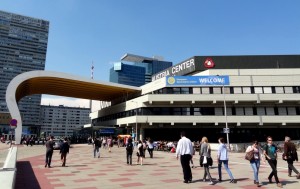Almost the entire group Risk participated to the European Geosciences Union General Assembly in Vienna, Austria, on 28 April to 2 May 2014. This huge meeting brought together over 12’000 scientists from over 100 countries. This is the world biggest meeting for natural hazards sciences. It is always an excellent opportunity for our group to meet new people and other scientists we work with for a long time.
The Group Risk presented 28 posters and 4 orals in the Natural Hazards division (titles listed below).
Titles of the Group Risk’s contributions to EGU 2014
- 3D granular deposits on rock avalanches: can the application of different operators and filtering techniques improve our understanding of the phenomena?
- A potentially catastrophic rockslide: the case of the Kilchenstock, Glarus (Switzerland)
- Analysis and modeling of a hail event consequences on a building portfolio
- Analysis of geohazards events along Swiss roads from autumn 2011 to present
- Building a LiDAR point cloud simulator: Testing algorithms for high resolution topographic change
- Consequence assessment of large rock slope failures in Norway
- Coupling high resolution 3D point clouds from terrestrial LiDAR with high precision displacement time series from GB-InSAR to understand landslide kinematic: example of the La Perraire instability, Swiss Alps.
- Erosion processes in molassic cliffs: the role of the rock surface temperature and atmospheric conditions
- Experimental and numerical understanding of a splashing drop onto fine sand samples
- GPU Accelerated Numerical Simulation of Viscous Flow Down a Slope
- Groundwater vulnerability in the District of Abidjan (Côte d’Ivoire)
- Impacts of the January 2014 extreme rainfall event on transportation network in the Alps Maritimes (France)
- Inshore analyse of the morphostructural evolution of the coastal cliffs of Bessin, Basse-Normandie, France
- Landscape processes, effects and the consequences of migration in their management at the Jatún Mayu watershed (Bolivia)
- Modelling of landslide failure surface using SLBL: from analogue modelling to real scale rotational landslides
- Modelling past landslide-induced tsunami in Lake Geneva to evaluate the present threat
- Multi-Criteria Decision Making for a Spatial Decision Support System on the Analysis of Changing Risk
- Peculiar debris-flow event of June 2013 in Livingstone mountain range (Alberta, Canada)
- Predicting the reactivation of a landslide from precipitation data. The example of a confidential landslide (Switzerland)
- Prototype development of a web-based participative decision support platform in risk management
- Regional-scale landslide risk analysis in the Swiss canton of Vaud
- Risk along a road from rheological data: application on Pont Bourquin landslide.
- Risk assessment on an Argentinean road with a dynamic traffic simulator
- Rockfall failure mechanisms in Yosemite Valley, California (USA)
- Rockfall magnitude-frequency estimation: how data acquistion strategies influence methodological results
- Rounbletz: An Excel-based software to perform cost-benefit analysis at local scale
- Search for synoptic precursors to extreme precipitation events in the Swiss Alps
- Sediment characterization, stocks and erodible relief quantification in alpine context using sloping local base level, from single watersheds to large-scale source-to-sink systems
- Site-specific assessment of the rockfall and the rock block volume distribution relations, using a LIDAR generated DEM
- Some aspects of risks and natural hazards in the rainfall variability space of Rwanda.
- The impact of the 2011 floods in Thailand on world economy using resilience concept
- The runout of granular material: from analogue to numerical modelling

